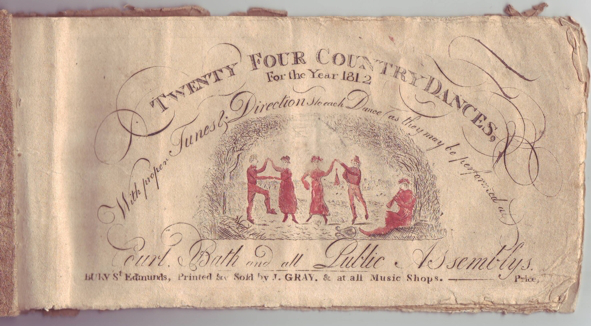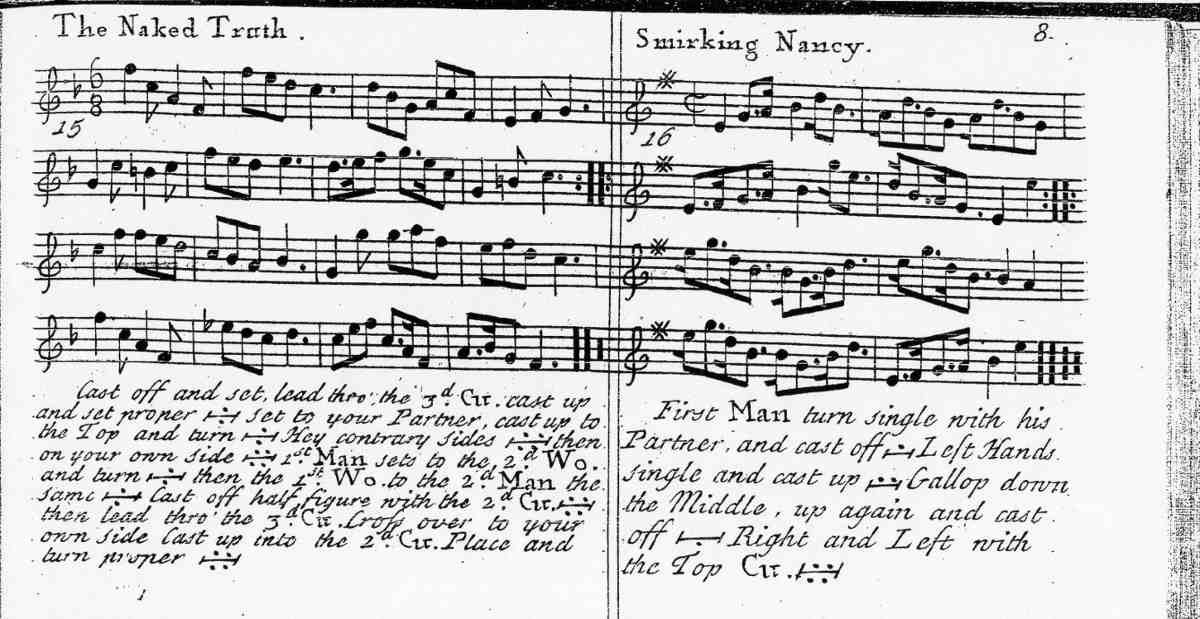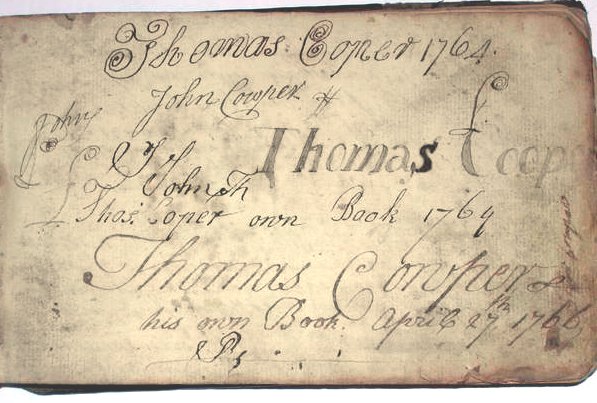
Back to Bits
& Bobs
Back to Homepage
Back to List of Articles
Since dancing was a very popular
leisure activity, and the industry around it both culturally and
economically valuable, encompassing music publishers, professional
and semi-professional musicians, peripatetic dancing
masters; and the assembly rooms, tavern rooms, and dancing
booths at fairs; nevertheless being an apparently frivolous
and inconsequential pastime it has not left many historical
accounts of itself. Mostly these are incidental, in the form of
newspaper reports, letters, diaries, anecdotes, court
records, poems, mentions in histories of pleasure gardens, and
some illustrations. Collection and study of all this will
eventually yield a coherent account of the various classes of
revellers, and the context of their dancing and music making.
There have been one or two scholars in
the past with an interest in this direction.
- John Malchair (1730-1812) (biog) was
an avid tune collector well before his time, collecting over 900
melodies into four manuscript volumes, one of which is held at the
Vaughan Wiliams Memorial Library. He is being studied by
Alice Little as part of her DPhil in Music at Oxford University.
- William
Chappell (1809-1888) (biog)
First published in 1838 as " A Collection of National English
Airs" and then expanded in 1855 into "Popular
Music of the Olden Time" (at IMSLP acc. 20-10-2017) this
work was the most significant contribution to the field in the
nineteenth century. The fact of it being still in print at the
present time is an indication of its worth .
- Frank Kidson (1855-1926) (biog)
in Leeds collected a prodigious amount of both manuscripts
and printed books, producing many articles for Grove's
Dictionary of Music , and his book British
Music Publishers* is the survey of the firms producing dance
music for popular consumption that is the essential starting point
for any study of the subject.
- Anne Gilchrist (1863-1954) (biog)
During the first half of the twentieth century in the North
West of England, produced a series of essays on tunes, for the
EFDSS and others.
- Cecil Sharp (1859-1924) (biog)
And there was C# of course, though he took the view that Eighteen
century and later music and dance didn't grow unaided out of the
English countryside, but was the result of upper class, or even
worse, foreign fashion and therefore not of relevance to his Folk
interests.
- P.J.S.Richardson (1875-1963) (biog)
In the middle twentieth century P.J.S. Richardson, President of
the Official Board of Ballroom Dancing produced the most
straightforward, though little known, guide to the subject - "The
Social Dances of the Nineteenth Century in England", which also
covered the earlier origins of social dance.
- EASMES (Early American Secular Music and it's
European Sources). In the late twentieth century Robert M. Keller,
Raoul F. Camus, Kate Van Winkle Keller, and Susan Cifaldi compiled
a title index of English dance tunes, http://www.cdss.org/elibrary/Easmes/index.html
- Some modern research is listed on the
Folkopedia website here
.
One way for melody to persist is in the memory, where it is
at liberty to mutate, under pressure from both external cultural
influences, such as changes in dance fashions for example, but not
least from internal creativity; and this is fundamental to the
evolution of culture. Unfortunately it is difficult to access
directly what goes on in people's minds, particularly if we want
to investigate the seventeenth century! However, written music
notation means that every now and then a moment in the evolution
of a tune gets recorded on paper.
Beginning in 1651 with Playford, and
continuing through the eighteenth and into the nineteenth
centuries, the major publishers of English dance directions with
their tunes were Walsh, Johnson, Thompson, Wilson, Preston and
others, many of which the Village Music Project volunteers have
transcribed.

In for example John GRAY; Twenty Four Country Dances for the Year 1812, (with proper tunes and directions for each dance as they may be performed at Court, Bath, and all Public Assemblys) (image courtesy of Katie Howson ) (link). It may have been both the first and the final moments of a hack's hopeful offering, but sometimes it was the springboard to greater fame!

A popular work of the period, like
John Johnson's Choice Collection of Favorite (200) Country Dances.
Vol.5 ; London: 1750; (link)
would contain a mixture of new and old material.

I should have shown a tune that became popular, but this does
illustrate the unfortunate fact that most of the tunes in these
books were, and remained despite their interesting titles, of
varying quality and obscure.
Music publishing firms, or music shops,
and even a few dancing masters would typically produce what they
hoped would become annual collections of 24 country dances with
tunes, some made up for the occasion, others found out in the
wild. When a sufficient number had accumulated they would be
reissued as a volume of 200. In this fashion Thompson eventually
printed six volumes, Walsh at least six, and Johnson eight, etc.
Playford, first in the field, was more haphazard, his Volume One
ran to eighteen different editions, eventually accumulating 535
tunes, and there were a further two large separate volumes in the
series. Frank Kidson's work on the subject can be found here.
And of course there were musicians' personal handwritten music
manuscript books, of varying sizes, each consisting of one
particular musician's choice of tunes, also many of which have
been transcribed by the VMP, as in COOPER/COWPER,Thomas MS, (c1770 of Dufton, near
Appleby, Westmorland). (link)

These were ephemera, consumables,
mostly only of interest to the musicians who used them, and
usually dispensed with as having no intrinsic value once they were
overtaken by new fashions, so despite having been produced in such
quantities over such a long period of time there is surprisingly
little of it remaining, and what remains has not been very
visible.
Although there is material to be had in archives, and selections
have occasionally been published, most of it, with rare
exceptions, has only been available if you wanted to see it
in unabridged form, by locating, visiting and handling the actual
copy in the library where it is kept. Consequently it has been
little visited beyond a small number of researchers, almost
literally gathering dust, and little regarded even by musicians.
The digital age has changed all that and made it possible, from
the late 1990s onwards, for more and more of it to be made
available online, both as facsimile images and as transcriptions.
It would be pointless providing
internet resources if they remained scattered and hard to find.
Surfing for arcane material on the internet, though faster than
visiting physical libraries, can still be a little like finding a
needle in a haystack if you don't already know what you're looking
for, and since the sort of material that interests me, and I hope,
other musicians, exists in scattered websites I thought it would
be useful to provide a portal. To this end I constructed three
lists, held on John Adams' Folkopedia Wiki.
http://folkopedia.efdss.org/wiki/Main_Page
The first page is a list of all the tune books containing mainly
tunes from the English repertoire printed since 1900 (fewer than
200 of these, mostly out of print)
http://folkopedia.efdss.org/wiki/Books_published_since_about_1900_containing_mainly_tunes_from_the_English_repertoire
The second is a list of tune books printed prior to 1900 (about
300 of these)
http://folkopedia.efdss.org/wiki/List_of_historical_tunebooks,_some_of_which_are_available_on_the_internet
And the third is a list of all the manuscript books I could find
or hear about that contain music of interest (about 300 of
these, I suspect there are as many again)
http://folkopedia.efdss.org/wiki/Tune_Manuscripts_List
On those Folkopedia pages I have provided links where there is an
online source which will enable closer examination of the
material. Many of those links point to the Village Music Project
files.
Over the last twenty years we at the
VMP have been identifying, and obtaining photocopies of,
historical tune collections, and producing transcriptions of them.
Our first website went live in 1998.
A volunteer transcribes the chosen collection into Chris Walshaw's ABC Music Notation language, another volunteer, sometimes myself, checks it for errors, and then I prepare it for publication on the website, sourcing an introduction and a little biography to go along with it if I can. We believe there is value in providing everything that a musician cared to put in his book, in order to give a full picture of his musical landscape.
We have so far provided transcriptions of over 5,000 tunes from printed collections, and 6,000 tunes from manuscript collections, a Grand Total of over 11,000 tunes!
These transcriptions then get
downloaded and used by musicians and publishers of tunebooks, (for
which we are always grateful when we receive the credit!); and the
Vaughan Williams Memorial Library, courtesy of Laura Smyth and
David Jacobs, have used some of them on the VWML website
The Village Music Project, of which I am co-director and
co-founder (with John Adams)
and transcript editor, is not the only online repository of
English dance tunes.
Other major collections are the Vaughan Williams Memorial Library website already mentioned
John Chambers' website http://trillian.mit.edu/~jc/music/book/
Chris Walshaw's ABCnotation website provides links to others
http://abcnotation.com/
Andrew Kuntz at the Traditional Tune Archive (which was formerly
The Fiddler's Companion), is interested in individual tunes from
all around the North Atlantic and their histories http://www.tunearch.org/wiki/Category:Tune
Chris Partington, 27/10/17
Back to List of Articles
Back to Bits
& Bobs
Back to Homepage